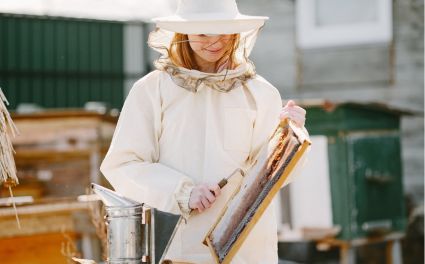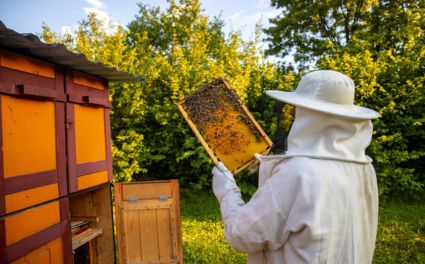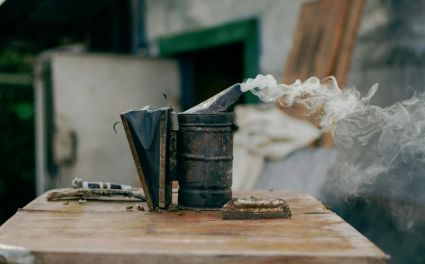Beekeeping has a deep connection with nature, requiring patience, keen observation, and the right tools to keep your colonies thriving. Moreover, traditional hive inspections come with their challenges, opening a hive can stress the bees, disrupt their activity, and even expose them to harmful environmental conditions.
What if you could check on your colony without lifting a single frame? Thanks to advancements in technology, beekeepers can now use thermal cameras for beekeeping to monitor hive temperature, detect brood clusters, and ensure colony health all without disturbing the bees.
Let’s have a deep dive into the fascinating world of beekeeping with infrared technology and explore its perks, applications, and expert tips for making the most of it.
Seeing The Hive Like Never Before: Why Beekeepers Love Thermal Imaging?
Thermal cameras provide a unique way to see what’s happening inside the hive by detecting heat signatures. Bees generate heat through their metabolic activity, especially in the winter when they cluster together to stay warm. With a thermal camera hive inspection, beekeepers can detect problems like queenlessness, brood patterns, and even signs of potential disease without opening the hive.

What A Thermal Camera Can Reveal About Your Hive’s Health?
Non-Intrusive Hive Monitoring:
Opening a hive exposes bees to temperature fluctuations, stress, and potential predators. With a thermal camera, you can monitor colony health without causing disruption.
Efficient Brood Cluster Detection:
Identifying the brood cluster is essential for assessing colony health. A thermal camera shows where bees are concentrated and whether they are forming a strong cluster.
Early Detection Of Hive Issues:
By tracking heat signatures in beehives, you can spot abnormalities, such as a weak queenless colony or irregular heat distribution, which might indicate disease or a dwindling population.
Winter Hive Survival Check:
During winter, it’s difficult to know whether your bees are alive and well. A thermal camera allows you to confirm that the cluster is intact and thriving without cracking open the hive and exposing it to the cold.
Quick Swarm Prevention Insight:
A sudden change in heat distribution might signal that the bees are preparing to swarm. Beekeepers can take proactive steps such as adding more space to the hive, splitting the colony, or checking for queen cells to manage the swarming process before losing half the colony.
Know Inside Out Thermal Hive Inspections: A Step-by-Step Guide
Using a thermal camera might seem high-tech, but it’s quite simple once you understand how to interpret the images. Here’s a step-by-step guide to conducting a thermal camera hive inspection:
Choose The Right Camera:
Not all infrared cameras are suited for beekeeping. Look for one with high thermal sensitivity and resolution to detect subtle changes in hive temperature.
Scan The Hive from Different Angles:
Point the camera at different parts of the hive front, sides, and top to get a full picture of heat distribution.
Interpret The Heat Patterns:
A strong, healthy colony should have a well-defined warm cluster in the center. If heat signatures are weak or scattered, further inspection may be needed.
Compare Over Time:
Take periodic readings to monitor changes in the hive’s heat patterns. Keeping a record helps detect trends and diagnose potential issues.
Insider Tricks For Getting The Best Thermal Camera Readings
-
Use In Low Light Conditions – The best readings often come when external temperature variations are minimal, such as early morning or late evening.
-
Calibrate Your Camera – Make sure that your camera settings are optimized for accurate temperature detection.
-
Pair With Physical Inspections – While thermal imaging provides incredible insight, it should be used alongside periodic hive inspections to confirm findings.
-
Monitor Ventilation Issues – Excessive heat buildup in summer might indicate poor airflow, leading to increased hive stress.
-
Winter Preparation – By checking heat distribution before winter, you can make necessary adjustments to insulation or hive positioning.
Stay Safe And Smart: Why OZ Armour Gear Complements Thermal Imaging?
Using a thermal camera for beekeeping is just one piece of the puzzle in effective hive management. To make the most of this technology, a beekeeper needs reliable gear to ensure safety and efficiency.
-
Beekeeping Suits: When a thermal camera reading suggests that a hive inspection is necessary, a high-quality suit protects against defensive bees while offering breathability and comfort.
-
Beekeeping Gloves: These gloves ensure a firm grip and hand protection while handling frames and tools.
-
Beekeeping Kids Suits: Keep your young helpers safe while they learn.
-
Beekeeping Veils: For flexible protection and clear visibility during inspections.
-
Pink Beekeeping Suits: Add style to safety with our standout pink suits.
-
Beekeeping Equipments: From smokers to hive tools, get everything in one place.
-
Beekeeping Kit With Suits: All-in-one kits that include suits and tools for beginners and pros.
-
Beekeeping Smoker: Calm your bees efficiently during inspections.
-
3-Layer Khaki Beekeeping Suit: Durable, breathable, and made for full protection.
-
Ventilated Beekeeping Suit: Designed to keep you cool and sting-free in every season.

Thermal Imaging And Traditional Beekeeping: The Best Partnership!
The integration of infrared cameras for beekeeping marks a new era in hive management. By using thermal imaging for hive health monitoring, beekeepers can make data-driven decisions that improve colony survival rates and productivity. Whether it’s detecting brood clusters with thermal imaging or ensuring hives are winter-ready, this technology offers an efficient and non-invasive way to keep bees thriving.
Furthermore, technology alone is not enough. A beekeeper’s best defense is a combination of observation, proper gear, and traditional management practices. Pairing beehive temperature monitoring with the right beekeeping gear—like our beekeeping suit and hive tools—ensures a smooth and stress-free beekeeping experience.
📝 Want to learn more? Read more blogs about beekeeping to expand your knowledge and keep your colonies thriving.




